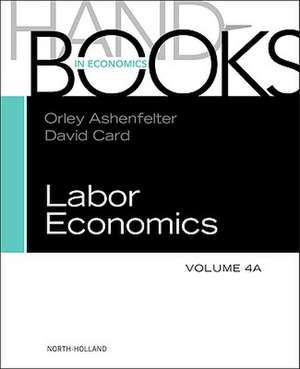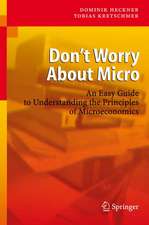Handbook of Labor Economics: Handbooks in Economics, cartea 4A
Editat de Orley Ashenfelter, David Carden Limba Engleză Hardback – 7 noi 2010
- Investigates recent advances in methods and models used in labor economics
- Demonstrates what these new tools and techniques can accomplish
- Documents how conceptual models and empirical work explain important practical issues
| Toate formatele și edițiile | Preț | Express |
|---|---|---|
| Hardback (2) | 717.68 lei 5-7 săpt. | |
| ELSEVIER SCIENCE – 7 noi 2010 | 717.68 lei 5-7 săpt. | |
| Elsevier – 9 noi 2010 | 729.09 lei 5-7 săpt. |
Din seria Handbooks in Economics
- 27%
 Preț: 682.50 lei
Preț: 682.50 lei - 27%
 Preț: 699.97 lei
Preț: 699.97 lei - 27%
 Preț: 881.91 lei
Preț: 881.91 lei - 22%
 Preț: 710.43 lei
Preț: 710.43 lei - 30%
 Preț: 666.05 lei
Preț: 666.05 lei - 31%
 Preț: 571.68 lei
Preț: 571.68 lei - 28%
 Preț: 689.62 lei
Preț: 689.62 lei - 31%
 Preț: 637.09 lei
Preț: 637.09 lei - 9%
 Preț: 697.92 lei
Preț: 697.92 lei - 23%
 Preț: 629.07 lei
Preț: 629.07 lei - 9%
 Preț: 756.72 lei
Preț: 756.72 lei - 23%
 Preț: 729.06 lei
Preț: 729.06 lei - 9%
 Preț: 682.69 lei
Preț: 682.69 lei - 9%
 Preț: 578.03 lei
Preț: 578.03 lei - 9%
 Preț: 696.12 lei
Preț: 696.12 lei - 23%
 Preț: 604.89 lei
Preț: 604.89 lei - 9%
 Preț: 623.34 lei
Preț: 623.34 lei - 27%
 Preț: 863.50 lei
Preț: 863.50 lei - 27%
 Preț: 830.07 lei
Preț: 830.07 lei - 9%
 Preț: 710.00 lei
Preț: 710.00 lei - 9%
 Preț: 674.31 lei
Preț: 674.31 lei - 31%
 Preț: 711.21 lei
Preț: 711.21 lei - 29%
 Preț: 706.71 lei
Preț: 706.71 lei - 27%
 Preț: 901.70 lei
Preț: 901.70 lei - 23%
 Preț: 656.12 lei
Preț: 656.12 lei
Preț: 717.68 lei
Preț vechi: 788.66 lei
-9% Nou
Puncte Express: 1077
Preț estimativ în valută:
137.35€ • 142.86$ • 113.39£
137.35€ • 142.86$ • 113.39£
Carte tipărită la comandă
Livrare economică 07-21 aprilie
Preluare comenzi: 021 569.72.76
Specificații
ISBN-13: 9780444534507
ISBN-10: 0444534504
Pagini: 864
Ilustrații: Illustrations
Dimensiuni: 156 x 234 x 48 mm
Greutate: 2.06 kg
Editura: ELSEVIER SCIENCE
Seria Handbooks in Economics
ISBN-10: 0444534504
Pagini: 864
Ilustrații: Illustrations
Dimensiuni: 156 x 234 x 48 mm
Greutate: 2.06 kg
Editura: ELSEVIER SCIENCE
Seria Handbooks in Economics
Public țintă
Graduate students and professors worldwide working in all subdisciplines of economics.Cuprins
Developments in Research Methods and their Application
1. Decomposition Methods in Economics
Nicole Fortin (University of British Columbia), Thomas Lemieux (University of British Columbia), and Sergio Firpo (Escola de Economia de São Paulo)
2. Field Experiments in Labor Economics
John List (University of Chicago) and Imran Rasul (University College London)
3. Lab Labor: What Can Labor Economists Learn from the Lab?
Gary Charness and Peter Kuhn (University of California at Santa Barbara)
4. The Structural Estimation of Behavioral Models: Discrete Choice Dynamic Programming Methods and Applications
Michael P. Keane (University of Technology, New South Wales), Kenneth I. Wolpin and Petra E. Todd (University of Pennsylvania)
5. Program Evaluation and Research Designs
John DiNardo (University of Michigan) and David S. Lee (Princeton University)
6. Identification of Models of Labor Market
Eric French (Federal Reserve Bank of Chicago) and Christopher Taber (University of Wisconsin at Madison)
7. Search in Macroeconomic Models of the Labor Market
Richard Rogerson (Arizona State University) and Robert Shimer (University of Chicago)
8. Extrinsic Rewards and Intrinsic Motives: Standard and Behavioral Approaches to Agency and Labor Markets
James B. Rebitzer (Boston University) and Lowell J. Taylor (Carnegie Mellon University)
1. Decomposition Methods in Economics
Nicole Fortin (University of British Columbia), Thomas Lemieux (University of British Columbia), and Sergio Firpo (Escola de Economia de São Paulo)
2. Field Experiments in Labor Economics
John List (University of Chicago) and Imran Rasul (University College London)
3. Lab Labor: What Can Labor Economists Learn from the Lab?
Gary Charness and Peter Kuhn (University of California at Santa Barbara)
4. The Structural Estimation of Behavioral Models: Discrete Choice Dynamic Programming Methods and Applications
Michael P. Keane (University of Technology, New South Wales), Kenneth I. Wolpin and Petra E. Todd (University of Pennsylvania)
5. Program Evaluation and Research Designs
John DiNardo (University of Michigan) and David S. Lee (Princeton University)
6. Identification of Models of Labor Market
Eric French (Federal Reserve Bank of Chicago) and Christopher Taber (University of Wisconsin at Madison)
7. Search in Macroeconomic Models of the Labor Market
Richard Rogerson (Arizona State University) and Robert Shimer (University of Chicago)
8. Extrinsic Rewards and Intrinsic Motives: Standard and Behavioral Approaches to Agency and Labor Markets
James B. Rebitzer (Boston University) and Lowell J. Taylor (Carnegie Mellon University)
Recenzii
"Labor economics" has continued to expand both in the extent and depth of coverage in recent years. Volume 4 of the Handbook has succeeded in not only updating coverage in many areas, but in synthesizing studies and approaches in ways that contribute importantly to the field. Economists with interests in many areas, ranging from field experiments to gender to early-life human capital investments, will benefit from the excellent chapters in this volume." --Jere R. Behrman, University of Pennsylvania
"Volume 4 very nicely illustrates several important trends in labor economics: increased concern about proper research design, more contact with those in other social sciences, greater reliance on data collected by those conducting the research, and (in some areas) more productive interplay between theory and data. The authors have themselves been major contributors to these developments; they combine a participant's enthusiasm with a detached perspective on the challenges and gaps that remain." --Charles C. Brown, University of Michigan
"The entries in the Handbook of Labor Economics update, deepen, and broaden the analyses contained in earlier volumes. The first-rate papers here address important problems in labor economics, often from new perspectives. As is the case with Volumes 1-3, many of the papers in volume 4 are "must-reads" and sure to make it onto graduate reading lists." --Henry Farber, Princeton University
"Volume 4 very nicely illustrates several important trends in labor economics: increased concern about proper research design, more contact with those in other social sciences, greater reliance on data collected by those conducting the research, and (in some areas) more productive interplay between theory and data. The authors have themselves been major contributors to these developments; they combine a participant's enthusiasm with a detached perspective on the challenges and gaps that remain." --Charles C. Brown, University of Michigan
"The entries in the Handbook of Labor Economics update, deepen, and broaden the analyses contained in earlier volumes. The first-rate papers here address important problems in labor economics, often from new perspectives. As is the case with Volumes 1-3, many of the papers in volume 4 are "must-reads" and sure to make it onto graduate reading lists." --Henry Farber, Princeton University





















